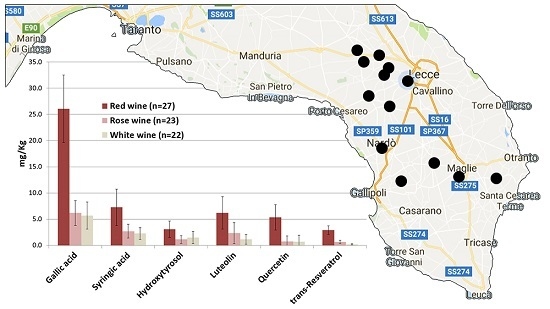A Comparative Study of Phenols in Apulian Italian Wines
Abstract
:1. Introduction
2. Materials and Methods
2.1. Chemicals
2.2. Samples
2.3. HPLC Analysis
2.4. Statistical Analysis
3. Results and Discussion
3.1. Red Wines
3.2. White Wines
3.3. Rose Wines
3.4. Statistical Multivariate Analysis
4. Conclusions
Acknowledgments
Author Contributions
Conflicts of Interest
References
- Georgiev, V.; Ananga, A.; Tsolova, V. Recent advances and uses of grape flavonoids as nutraceuticals. Nutrients 2014, 6, 391–415. [Google Scholar] [CrossRef] [PubMed]
- De Quiros, A.R.B.; Lage-Yusty, M.A.; Lopez-Hernandez, J. Hplc-analysis of polyphenolic compounds in spanish white wines and determination of their antioxidant activity by radical scavenging assay. Food Res. Int. 2009, 42, 1018–1022. [Google Scholar] [CrossRef]
- Duthie, G.G.; Duthie, S.J.; Kyle, J.A.M. Plant polyphenols in cancer and heart disease: Implications as nutritional antioxidants. Nutr. Res. Rev. 2000, 13, 79–106. [Google Scholar] [CrossRef] [PubMed]
- Giovinazzo, G.; Grieco, F. Functional properties of grape and wine polyphenols. Plant Food Hum. Nutr. 2015, 70, 454–462. [Google Scholar] [CrossRef] [PubMed]
- Pandey, K.B.; Rizvi, S.I. Plant polyphenols as dietary antioxidants in human health and disease. Oxid. Med. Cell. Longev. 2009, 2, 270–278. [Google Scholar] [CrossRef] [PubMed]
- Arranz, S.; Chiva-Blanch, G.; Valderas-Martinez, P.; Medina-Remon, A.; Lamuela-Raventos, R.M.; Estruch, R. Wine, beer, alcohol and polyphenols on cardiovascular disease and cancer. Nutrients 2012, 4, 759–781. [Google Scholar] [CrossRef] [PubMed]
- Tsao, R. Chemistry and biochemistry of dietary polyphenols. Nutrients 2010, 2, 1231–1246. [Google Scholar] [CrossRef] [PubMed]
- Lachman, J.; Sulc, M.; Schilla, M. Comparison of the total antioxidant status of bohemian wines during the wine-making process. Food Chem. 2007, 103, 802–807. [Google Scholar] [CrossRef]
- Peri, P.; Kamiloglu, S.; Capanoglu, E.; Ozcelik, B. Investigating the effect of aging on the phenolic content, antioxidant activity and anthocyanins in turkish wines. J. Food Process. Preserv. 2015, 39, 1845–1853. [Google Scholar] [CrossRef]
- Liu, Y.Q.; Pukala, T.L.; Musgrave, I.F.; Williams, D.M.; Dehle, F.C.; Carver, J.A. Gallic acid is the major component of grape seed extract that inhibits amyloid fibril formation. Bioorg. Med. Chem. Lett. 2013, 23, 6336–6340. [Google Scholar] [CrossRef] [PubMed]
- Liu, Y.Q.; Carver, J.A.; Calabrese, A.N.; Pukala, T.L. Gallic acid interacts with alpha-synuclein to prevent the structural collapse necessary for its aggregation. Biochim. Biophys. Acta-Proteins Proteom. 2014, 1844, 1481–1485. [Google Scholar] [CrossRef] [PubMed]
- Wang, Y.J.; Thomas, P.; Zhong, J.H.; Bi, F.F.; Kosaraju, S.; Pollard, A.; Fenech, M.; Zhou, X.F. Consumption of grape seed extract prevents amyloid-beta deposition and attenuates inflammation in brain of an Alzheimer’s disease mouse. Neurotox. Res. 2009, 15, 3–14. [Google Scholar] [CrossRef] [PubMed]
- Hollman, P.C.H.; Katan, M.B. Absorption, metabolism and health effects of dietary flavonoids in man. Biomed. Pharmacother. 1997, 51, 305–310. [Google Scholar] [CrossRef]
- Lopez-Lazaro, M. Distribution and biological activities of the flavonoid luteolin. Mini-Rev. Med. Chem. 2009, 9, 31–59. [Google Scholar] [CrossRef] [PubMed]
- Hagiwara, K.; Goto, T.; Araki, M.; Miyazaki, H.; Hagiwara, H. Olive polyphenol hydroxytyrosol prevents bone loss. Eur. J. Pharmacol. 2011, 662, 78–84. [Google Scholar] [CrossRef] [PubMed]
- Gonzalez-Santiago, M.; Martin-Bautista, E.; Carrero, J.J.; Fonolla, J.; Baro, L.; Bartolome, M.V.; Gil-Loyzaga, P.; Lopez-Huertas, E. One-month administration of hydroxytyrosol, a phenolic antioxidant present in olive oil, to hyperlipemic rabbits improves blood lipid profile, antioxidant status and reduces atherosclerosis development. Atherosclerosis 2006, 188, 35–42. [Google Scholar] [CrossRef] [PubMed]
- Vazquez-Velasco, M.; Diaz, L.E.; Lucas, R.; Gomez-Martinez, S.; Bastida, S.; Marcos, A.; Sanchez-Muniz, F.J. Effects of hydroxytyrosol-enriched sunflower oil consumption on cvd risk factors. Br. J. Nutr. 2011, 105, 1448–1452. [Google Scholar] [CrossRef] [PubMed]
- Schaffer, S.; Podstawa, M.; Visioli, F.; Bogani, P.; Muller, W.E.; Eckert, G.P. Hydroxytyrosol-rich olive mill wastewater extract protects brain cells in vitro and ex vivo. J. Agric. Food Chem. 2007, 55, 5043–5049. [Google Scholar] [CrossRef] [PubMed]
- Warleta, F.; Quesada, C.S.; Campos, M.; Allouche, Y.; Beltran, G.; Gaforio, J.J. Hydroxytyrosol protects against oxidative DNA damage in human breast cells. Nutrients 2011, 3, 839–857. [Google Scholar] [CrossRef] [PubMed]
- Ristagno, G.; Fumagalli, F.; Porretta-Serapiglia, C.; Orru, A.; Cassina, C.; Pesaresi, M.; Masson, S.; Villanova, L.; Merendino, A.; Villanova, A.; et al. Hydroxytyrosol attenuates peripheral neuropathy in streptozotocin-induced diabetes in rats. J. Agric. Food Chem. 2012, 60, 5859–5865. [Google Scholar] [CrossRef] [PubMed]
- Brown, L.; Kroon, P.A.; Das, D.K.; Das, S.; Tosaki, A.; Chan, V.; Singer, M.V.; Feick, P. The biological responses to resveratrol and other polyphenols from alcoholic beverages. Alcohol.-Clin. Exp. Res. 2009, 33, 1513–1523. [Google Scholar] [CrossRef] [PubMed]
- Nassiri-Asl, M.; Hosseinzadeh, H. Review of the pharmacological effects of vitis vinifera (grape) and its bioactive compounds. Phytother. Res. 2009, 23, 1197–1204. [Google Scholar] [CrossRef] [PubMed]
- Neves, A.R.; Lucio, M.; Lima, J.L.C.; Reis, S. Resveratrol in medicinal chemistry: A critical review of its pharmacokinetics, drug-delivery, and membrane interactions. Curr. Med. Chem. 2012, 19, 1663–1681. [Google Scholar] [CrossRef] [PubMed]
- Vergara, D.; Valente, C.M.; Tinelli, A.; Siciliano, C.; Lorusso, V.; Acierno, R.; Giovinazzo, G.; Santino, A.; Storelli, C.; Maffia, M. Resveratrol inhibits the epidermal growth factor-induced epithelial mesenchymal transition in mcf-7 cells. Cancer Lett. 2011, 310, 1–8. [Google Scholar] [CrossRef] [PubMed]
- Toaldo, I.M.; Van Camp, J.; Gonzales, G.B.; Kamiloglu, S.; Bordignon-Luiz, M.T.; Smagghe, G.; Raes, K.; Capanoglu, E.; Grootaert, C. Resveratrol improves tnf-alpha-induced endothelial dysfunction in a coculture model of a caco-2 with an endothelial cell line. J. Nutr. Biochem. 2016, 36, 21–30. [Google Scholar] [CrossRef] [PubMed]
- Brescia, M.A.; Caldarola, V.; De Giglio, A.; Benedetti, D.; Fanizzi, F.P.; Sacco, A. Characterization of the geographical origin of italian red wines based on traditional and nuclear magnetic resonance spectrometric determinations. Anal. Chim. Acta 2002, 458, 177–186. [Google Scholar] [CrossRef]
- De Pascali, S.A.; Coletta, A.; Del Coco, L.; Basile, T.; Gambacorta, G.; Fanizzi, F.P. Viticultural practice and winemaking effects on metabolic profile of negroamaro. Food Chem. 2014, 161, 112–119. [Google Scholar] [CrossRef] [PubMed]
- Ragone, R.; Crupi, P.; Piccinonna, S.; Bergamini, C.; Mazzone, F.; Fanizzi, F.P.; Schena, F.P.; Antonacci, D. Classification and chemometric study of southern italy monovarietal wines based on NMR and HPLC-DAD-MS. Food Sci. Biotechnol. 2015, 24, 817–826. [Google Scholar] [CrossRef]
- Crupi, P.; Coletta, A.; Antonacci, D. Analysis of carotenoids in grapes to predict norisoprenoid varietal aroma of wines from apulia. J. Agric. Food Chem. 2010, 58, 9647–9656. [Google Scholar] [CrossRef] [PubMed]
- Crupi, P.; Coletta, A.; Milella, R.A.; Palmisano, G.; Baiano, A.; La Notte, E.; Antonacci, D. Carotenoid and chlorophyll-derived compounds in some wine grapes grown in Apulian region. J. Food Sci. 2010, 75, S191–S198. [Google Scholar] [CrossRef] [PubMed]
- Crupi, P.; Coletta, A.; Milella, R.A.; Perniola, R.; Gasparro, M.; Genghi, R.; Antonacci, D. HPLC-DAD-ESI-MS analysis of flavonoid compounds in 5 seedless table grapes grown in Apulian region. J. Food Sci. 2012, 77, C174–C181. [Google Scholar] [CrossRef] [PubMed]
- Capone, S.; Tufariello, M.; Francioso, L.; Montagna, G.; Casino, F.; Leone, A.; Siciliano, P. Aroma analysis by GC/MS and electronic nose dedicated to negroamaro and primitivo typical Italian Apulian wines. Sens. Actuators B-Chem. 2013, 179, 259–269. [Google Scholar] [CrossRef]
- Tufariello, M.; Capone, S.; Siciliano, P. Volatile components of negroamaro red wines produced in Apulian Salento area. Food Chem. 2012, 132, 2155–2164. [Google Scholar] [CrossRef]
- Barnaba, C.; Dellacassa, E.; Nicolini, G.; Nardin, T.; Malacarne, M.; Larcher, R. Free and glycosylated simple phenol profiling in Apulian Italian wines. Food Chem. 2016, 206, 260–266. [Google Scholar] [CrossRef] [PubMed]
- Weiskirchen, S.; Weiskirchen, R. Resveratrol: How much wine do you have to drink to stay healthy? Adv. Nutr. 2016, 7, 706–718. [Google Scholar] [CrossRef] [PubMed]
- Bonnefont-Rousselot, D. Resveratrol and cardiovascular diseases. Nutrients 2016, 8, 24. [Google Scholar] [CrossRef] [PubMed]
- Artero, A.; Artero, A.; Tarin, J.J.; Cano, A. The impact of moderate wine consumption on health. Maturitas 2015, 80, 3–13. [Google Scholar] [CrossRef] [PubMed]
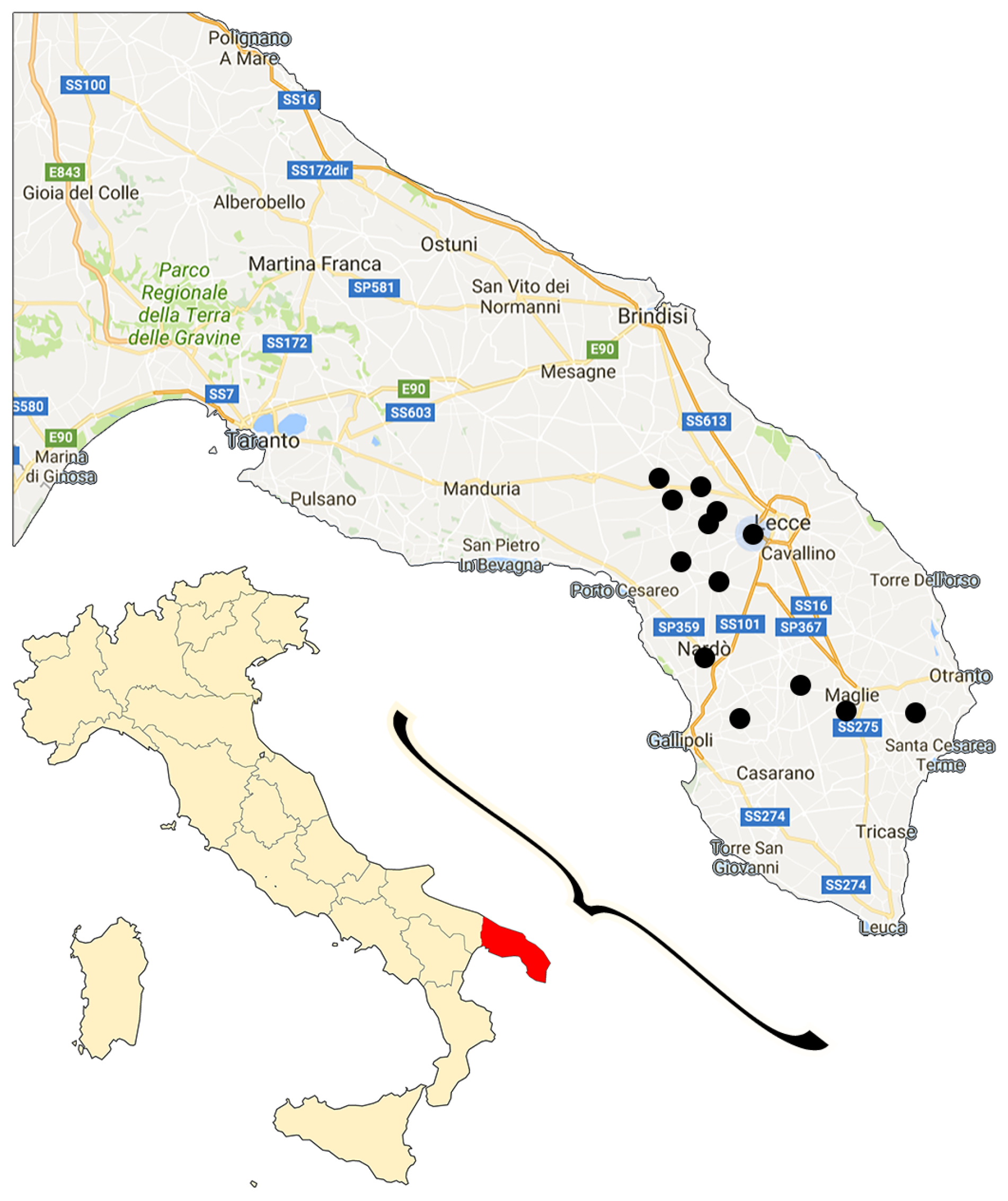
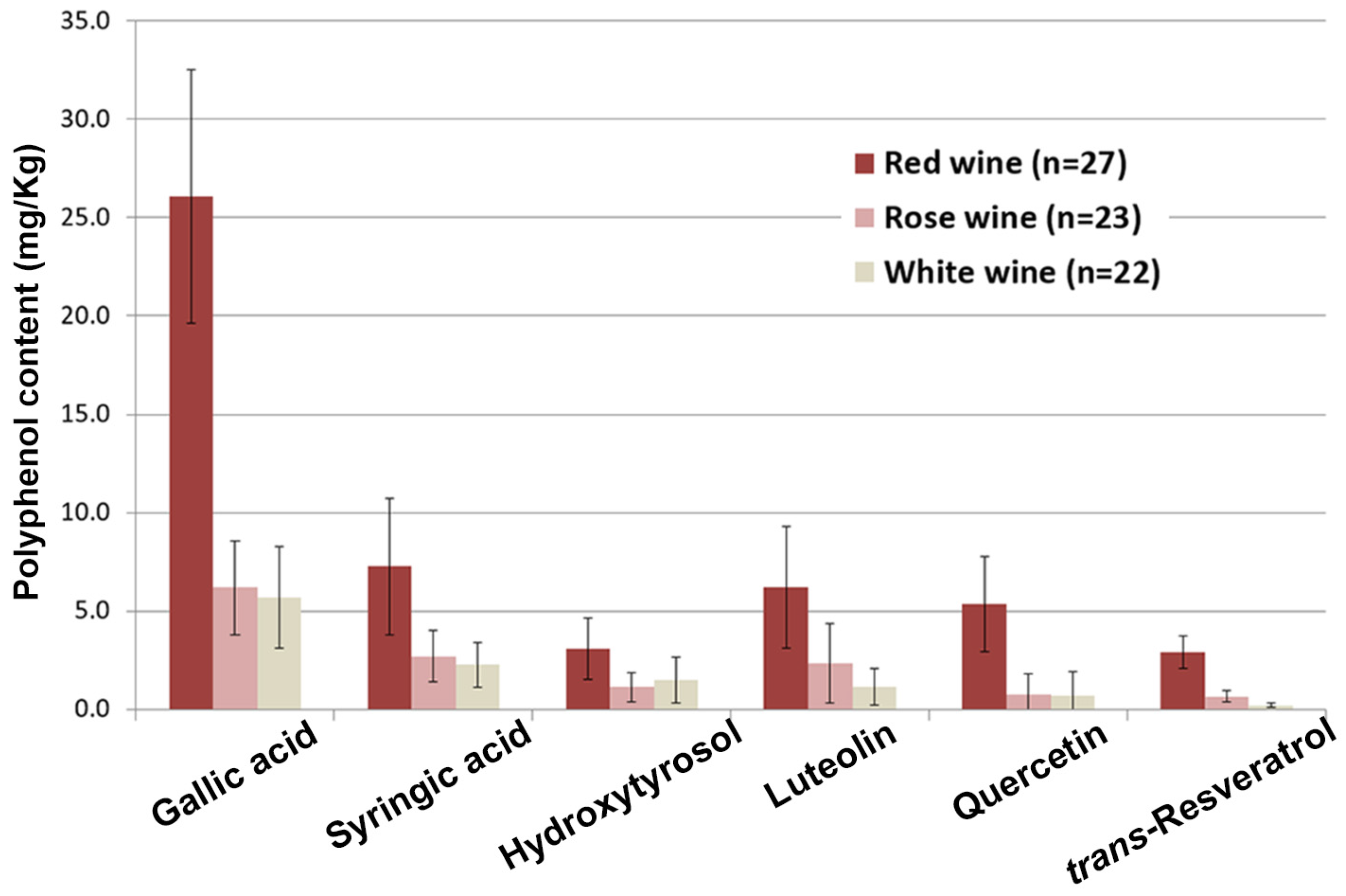
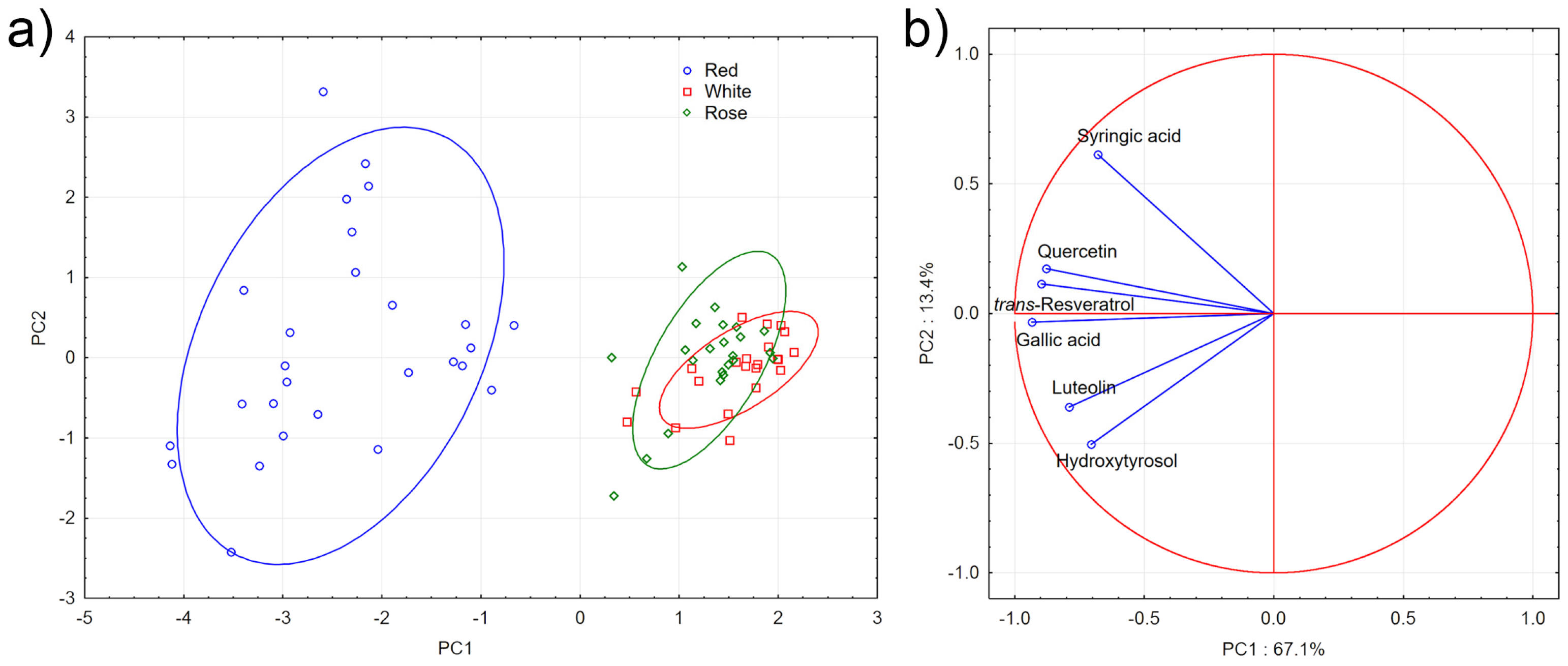
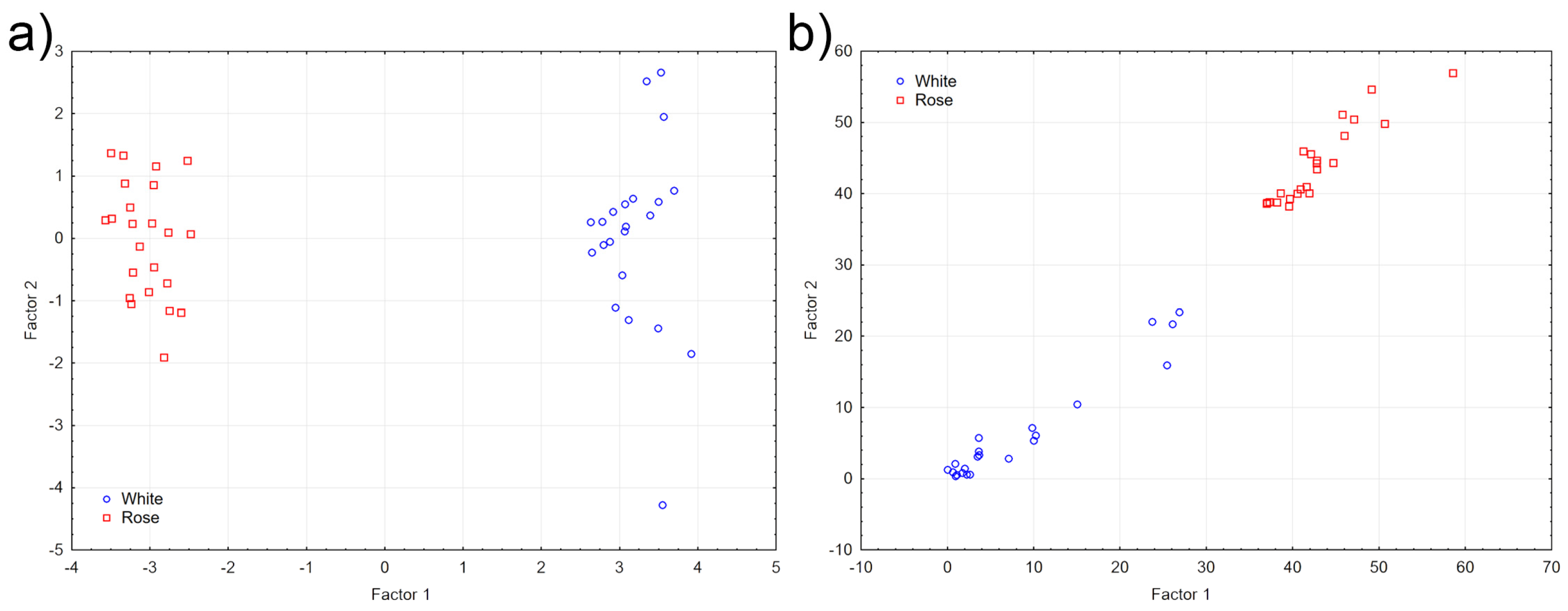
| Wine Color | Grape Type | n of Samples | Year 1 | Alcoholic Grade 2 | Gallic Acid | Syringic Acid | Hydroxytyrosol | Luteolin | Quercetin | trans-Resveratrol |
|---|---|---|---|---|---|---|---|---|---|---|
| Content in mg/kg 2 | ||||||||||
| Red | Blend | 4 | 2010–2013 | 13.5 ± 0.4 | 23.7 ± 4.0 | 7.6 ± 4.2 | 2.9 ± 1.0 | 5.7 ± 3.2 | 5.8 ± 1.3 | 2.9 ± 0.3 |
| Negroamaro | 16 | 2007–2013 | 13.6 ± 0.7 | 26.8 ± 7.4 | 7.2 ± 3.4 | 3.4 ± 1.8 | 6.3 ± 3.4 | 5.5 ± 2.7 | 2.8 ± 0.7 | |
| Primitivo | 5 | 2011–2012 | 13.6 ± 0.2 | 24.9 ± 7.0 | 7.8 ± 4.5 | 2.5 ± 1.1 | 6.0 ± 3.2 | 4.8 ± 3.4 | 2.8 ± 0.9 | |
| Susumaniello | 2 | 2012 | 13.3 ± 0.4 | 28.0 ± 2.2 | 5.2 ± 3.3 | 2.7 ± 2.1 | 7.2 ± 2.4 | 5.0 ± 1.4 | 4.3 ± 1.5 | |
| White | Bianco d’Alessano | 1 | 2013 | 12.0 | 2.7 | 2.0 | 0.9 | 1.1 | ND 3 | 0.2 |
| Blend | 4 | 2012–2013 | 12.6 ± 1.5 | 4.5 ± 1.1 | 2.2 ± 0.6 | 1.3 ± 0.9 | 0.8 ± 0.5 | 0.0 ± 0.0 | 0.2 ± 0.1 | |
| Chardonnay | 9 | 2012–2013 | 13.1 ± 0.8 | 5.5 ± 1.4 | 2.2 ± 1.7 | 2.3 ± 1.3 | 1.3 ± 0.7 | 1.2 ± 1.8 | 0.2 ± 0.1 | |
| Falanghina | 1 | 2013 | 12.5 | 5.3 | 2.3 | 0.8 | 0.7 | ND | 0.3 | |
| Fiano | 3 | 2013 | 13.0 ± 1.0 | 8.1 ± 4.1 | 1.8 ± 0.3 | 1.1 ± 0.3 | 0.6 ± 0.3 | 0.3 ± 0.6 | 0.1 ± 0.1 | |
| Malvasia | 1 | 2013 | 13.0 | 4.5 | 3.6 | 0.6 | 1.1 | 1.0 | 0.3 | |
| Moscato | 1 | 2012 | 14.5 | 12.5 | 2.0 | 0.2 | 4.5 | 1.0 | 0.3 | |
| Negroamaro | 1 | 2013 | 12.5 | 3.0 | 2.8 | 0.6 | 0.6 | ND | 0.1 | |
| Verdecca | 1 | 2013 | 12.5 | 5.5 | 2.7 | 0.4 | 0.5 | ND | 0.5 | |
| Rose | Negroamaro | 18 | 2011–2013 | 12.9 ± 0.5 | 5.9 ± 2.1 | 2.7 ± 1.4 | 1.2 ± 0.8 | 2.3 ± 2.2 | 0.6 ± 0.8 | 0.6 ± 0.2 |
| Negroamaro and Malvasia Nera | 4 | 2013 | 12.9 ± 0.6 | 7.4 ± 3.7 | 2.5 ± 0.7 | 1.1 ± 0.4 | 2.4 ± 1.6 | 1.6 ± 1.8 | 0.8 ± 0.4 | |
| Primitivo | 1 | 2013 | 13.5 | 5.5 | 3.6 | 1.1 | 1.8 | ND | 0.6 | |
© 2017 by the authors. Licensee MDPI, Basel, Switzerland. This article is an open access article distributed under the terms and conditions of the Creative Commons Attribution (CC BY) license (http://creativecommons.org/licenses/by/4.0/).
Share and Cite
Ragusa, A.; Centonze, C.; Grasso, M.E.; Latronico, M.F.; Mastrangelo, P.F.; Sparascio, F.; Fanizzi, F.P.; Maffia, M. A Comparative Study of Phenols in Apulian Italian Wines. Foods 2017, 6, 24. https://doi.org/10.3390/foods6040024
Ragusa A, Centonze C, Grasso ME, Latronico MF, Mastrangelo PF, Sparascio F, Fanizzi FP, Maffia M. A Comparative Study of Phenols in Apulian Italian Wines. Foods. 2017; 6(4):24. https://doi.org/10.3390/foods6040024
Chicago/Turabian StyleRagusa, Andrea, Carla Centonze, Maria E. Grasso, Maria F. Latronico, Pier F. Mastrangelo, Federica Sparascio, Francesco P. Fanizzi, and Michele Maffia. 2017. "A Comparative Study of Phenols in Apulian Italian Wines" Foods 6, no. 4: 24. https://doi.org/10.3390/foods6040024
APA StyleRagusa, A., Centonze, C., Grasso, M. E., Latronico, M. F., Mastrangelo, P. F., Sparascio, F., Fanizzi, F. P., & Maffia, M. (2017). A Comparative Study of Phenols in Apulian Italian Wines. Foods, 6(4), 24. https://doi.org/10.3390/foods6040024








